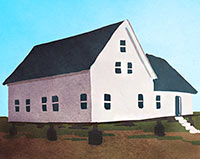COMMENT OF THE DAY RUNNER-UP: FEAR OF A RAISED FOUNDATION  “What I’ve found to be true, anecdotally at least, is that most people who have never lived in a house with a pier and beam foundation have ZERO interest in them. They are disoriented, confused by, and even scared of them. Some of them are a little creeped out by the thought of having empty space under their floorboards. (What’s that noise? Will I have to go down there at some point?!?!?) Despite some of the most beautiful and pricey homes being built in this way, some of these people still see it as antiquated and, even, a sign of shoddy construction not designed to last.” [driftwood, commenting on How About We Don’t Sell People Homes in Areas That Keep Flooding, and Other Crazy Ideas for Houstonians To Discuss Amongst Themselves] Illustration: Lulu
“What I’ve found to be true, anecdotally at least, is that most people who have never lived in a house with a pier and beam foundation have ZERO interest in them. They are disoriented, confused by, and even scared of them. Some of them are a little creeped out by the thought of having empty space under their floorboards. (What’s that noise? Will I have to go down there at some point?!?!?) Despite some of the most beautiful and pricey homes being built in this way, some of these people still see it as antiquated and, even, a sign of shoddy construction not designed to last.” [driftwood, commenting on How About We Don’t Sell People Homes in Areas That Keep Flooding, and Other Crazy Ideas for Houstonians To Discuss Amongst Themselves] Illustration: Lulu





Thirty years ago, I once had a P&B house near RO center, and heard snotty remarks that it was just a little thing ‘up on blocks’ , as if it were a ’76 Le Sabre sitting in the yard. So yeah, I get the thing about P&B perception. Also, the bottom skirt can look tatty unless some effort is made.
Love, love, love my 1940 pier & beam house, filled with solid doors and gorgeous wood floors. Particularly since it is high and dry. Not to mention it looks better and is in better shape than many new builds – and will be for years to come.
I am actually surprised that people in Houston haven’t gravitated to pier and beam after getting huge bills for foundation repair. Leveling a pier and beam house is a few hundred bucks for a couple of guys with jacks and little pieces of metal. Leveling a slab is crazy expensive and is usually so drastic that giant cracks open up in the walls.
Our Montrose house is a bit over 100 years old and p&b. It’s great. I’m with you guys — not sure why it’s not more common.
Yep slabs are cheap to throw down and cause headaches later – but that’s the Houston way.
I’ve lived in 2 P&B houses: one in North Harris County -built in 1907 and my maternal grandparents house built in 1939 near SouthWest Freeway (aka Hey59/69) and Richmond/Shepherd/Woodhead. Neither ever flooded-as they were 5 feet and 3 feet,respectively off the ground. I tell people after HArvey ,if you’re building a new home, have the lot graded at least 4 feet above the surrounding area. Cause by the time the wussies aka the fricking politicians get some backbone and actually start pushing long over due infrastructure improvements through, your neighborhood will have flooded several more times. I grew up in Bellaire & Meyerland , so I have a bot of perspective into this flooding issue. And besides, when I’m building a new home anywhere in Houston, I want the sucker NOT to flood and those crappy,NON builder pier slabs don’t do diddly . I say up & away. There are builders who already were grading the lots 2-3 feet higher . I say do it all over town.
“Yep slabs are cheap to throw down and cause headaches later – but that’s the Houston way.”? That is the way of wealthy societies, be they in Houston or elsewhere. It is a rational decision and provides homes for many thousands of people who otherwise could not afford to build a house with an unlimited expected lifetime.
All of this foundation talk begs a question. How much did the switch from pier-and-beam to cheaper, easier, flimsier and non-absorbent slab foundations contribute to flooding? What is the real difference in cost-of-construction?
Remember, you cannot simply jack up a slab house.
Fine. Let’s go back to pier and beam construction, but remember that is one more place for clowns to hide.
Not only floods but spending your life walking on concrete can wear those joints out…block and beam houses have floors with some give…a dog scratching vigorously will shake it…gotta believe it helps the human body.
@Pat,
While the area under a P&B house is in theory permeable cover, it doesn’t get rained on. In most cases, rain that falls on the roof ends up running into the gutters and draining into the street.
In the case of my house, during the most intense periods of rain during Harvey, my entire lot was under a few inches of water, meaning there was a layer of water in the space under the house, some of which may have permeated into the soil. But since the lot is graded toward the street, once the rain slowed down from 6 inches per hour to 1-2, the vast majority of that water soon made its way into the storm drains.
Why would people be afraid of the space under the house? It’s an amazing place to store things like bodies.